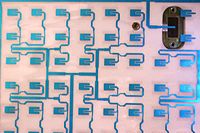Microstrip antenna

Microstrip antennas are like little flat pieces of metal that send and receive signals. They are often used in things like cell phones and Wi-Fi routers.
Imagine you're playing a game of telephone with your friends. You start by whispering a message into your friend's ear, they pass it on to the next person, and so on until it reaches the end. But what if you could send a message without having to rely on your friends to pass it along? That's where microstrip antennas come in.
Instead of relying on people to pass a message along, microstrip antennas use something called electromagnetic waves to send and receive messages. These waves are formed when electricity is sent through the metal strip. The electricity causes the metal strip to create a magnetic field that oscillates (moves back and forth) up and down. This motion creates waves in the air that travel away from the metal strip in all directions.
But how does the antenna know where to send the waves? Remember those electromagnetic waves we talked about? Well those waves can be "tuned" to a specific frequency by changing the size and shape of the metal strip. This means it can be set up to send and receive specific signals, like cell phone calls or Wi-Fi signals.
So next time you use your cell phone or connect to Wi-Fi, remember that you're using a tiny, flat piece of metal that uses electromagnetic waves to send and receive messages!
Imagine you're playing a game of telephone with your friends. You start by whispering a message into your friend's ear, they pass it on to the next person, and so on until it reaches the end. But what if you could send a message without having to rely on your friends to pass it along? That's where microstrip antennas come in.
Instead of relying on people to pass a message along, microstrip antennas use something called electromagnetic waves to send and receive messages. These waves are formed when electricity is sent through the metal strip. The electricity causes the metal strip to create a magnetic field that oscillates (moves back and forth) up and down. This motion creates waves in the air that travel away from the metal strip in all directions.
But how does the antenna know where to send the waves? Remember those electromagnetic waves we talked about? Well those waves can be "tuned" to a specific frequency by changing the size and shape of the metal strip. This means it can be set up to send and receive specific signals, like cell phone calls or Wi-Fi signals.
So next time you use your cell phone or connect to Wi-Fi, remember that you're using a tiny, flat piece of metal that uses electromagnetic waves to send and receive messages!
Related topics others have asked about:
